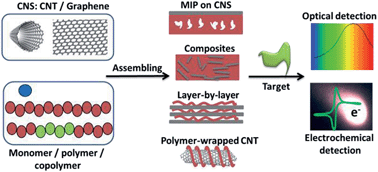Chemical sensors based on polymer composites with carbon nanotubes and graphene: the role of the polymer
Abstract
This review provides an overview of recent research on chemical sensors based on polymer composites with carbon nanotubes (CNTs) and graphene (G) for quantitative and qualitative analysis in diverse application fields such as biosensing (DNA, enzymes, proteins, antigens and metabolites), and chemical and gas sensing using electrochemical and optical detection methods. Both CNTs and G show outstanding electrical, chemical, electrochemical and optical properties that make them ideal candidates for use in chemical sensors. The incorporation of polymers into the development of this type of sensor not only improves the CNT and G dispersion, but also enhances some of their properties like redox behaviour and biocompatibility, and provides additional properties such as photoelectric or swelling capacity. Moreover, unique synergistic effects arising from the combination of the matrix and nanofiller contributions are described by means of several examples highlighting the most important achievements in this field. Special emphasis has been placed throughout the review on analysing the role of the polymer in different sensing platforms. The combination of polymers with carbon nanomaterials for the preparation of chemical sensors opens up exciting areas of research due to their biocompatibility, and excellent sensitivity and selectivity.


 Please wait while we load your content...
Please wait while we load your content...